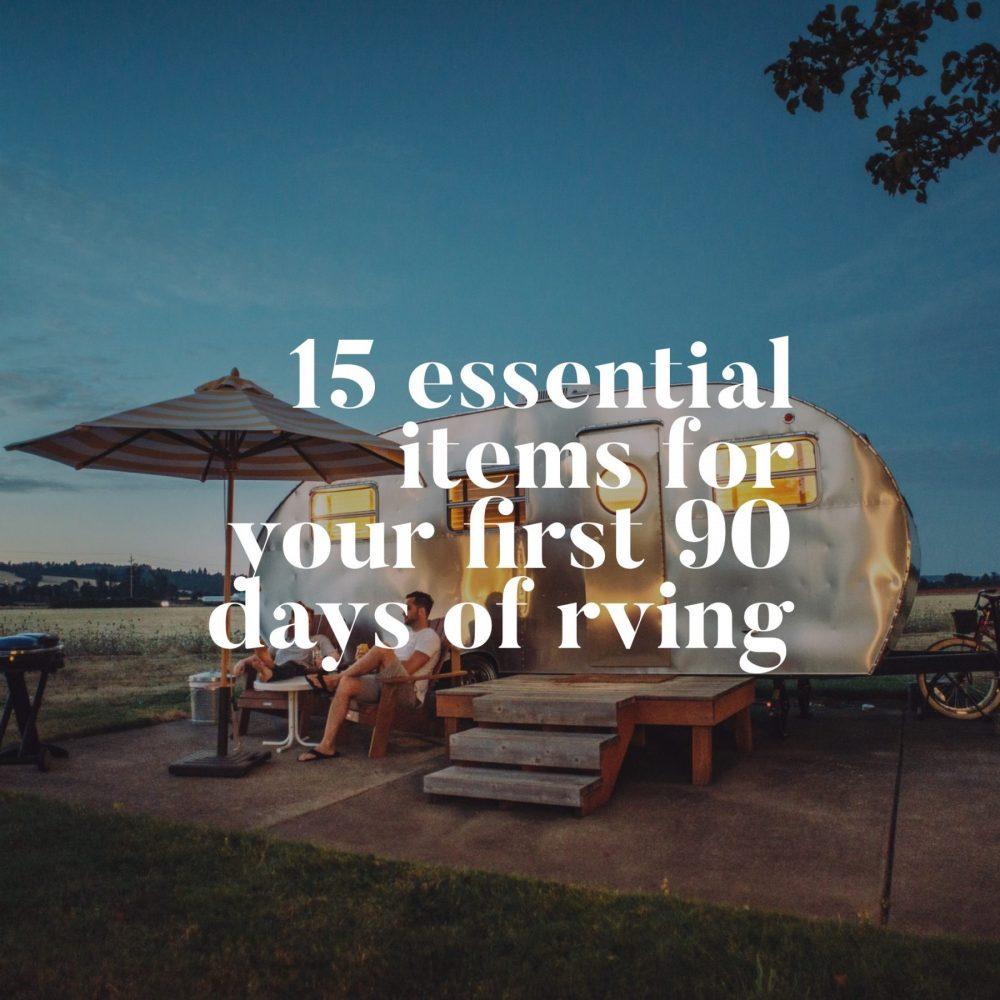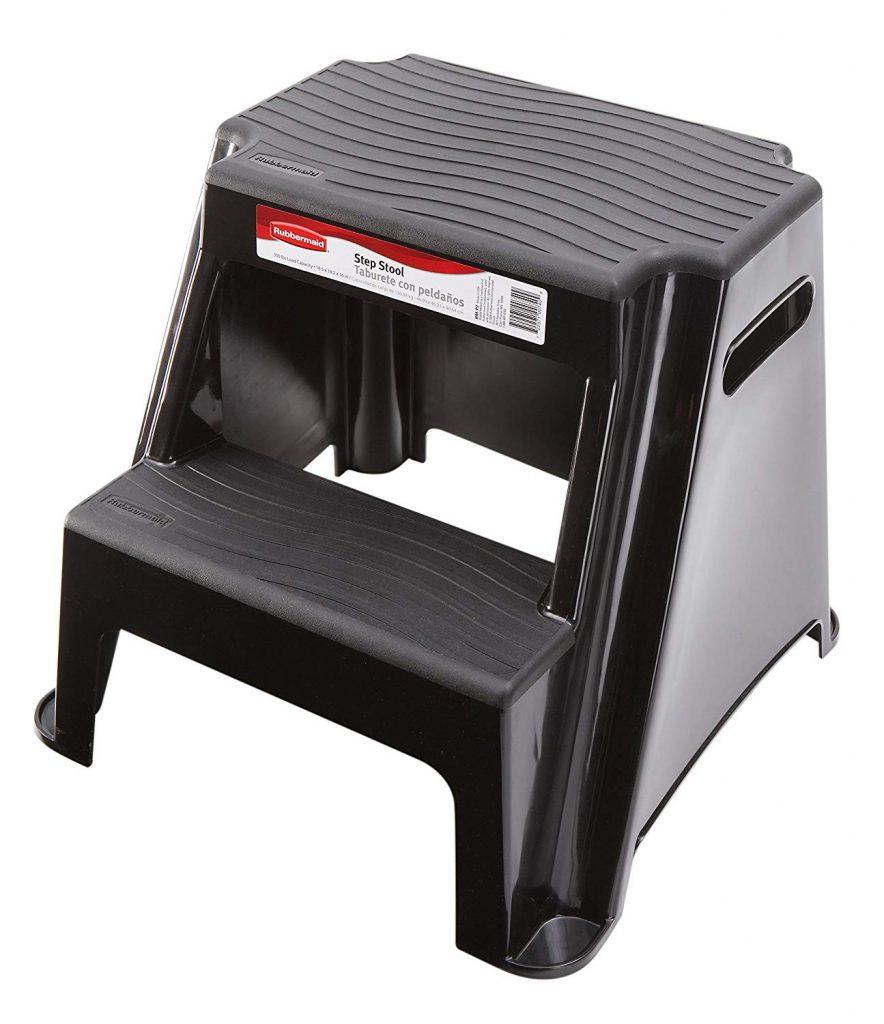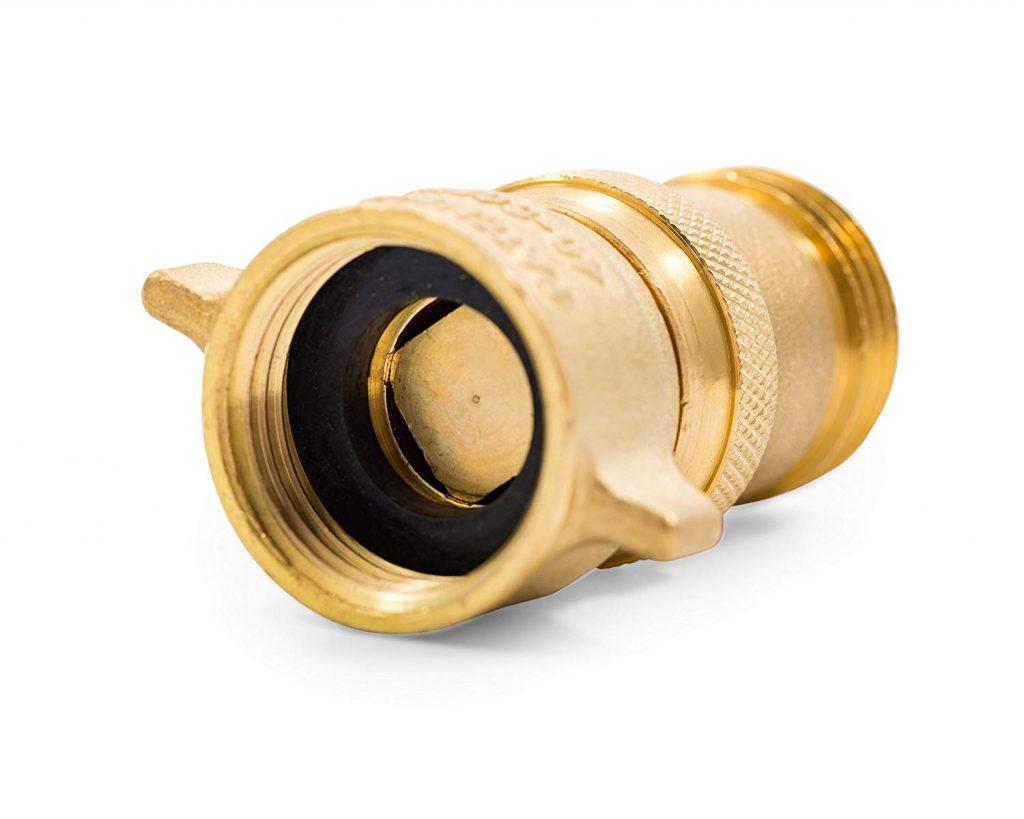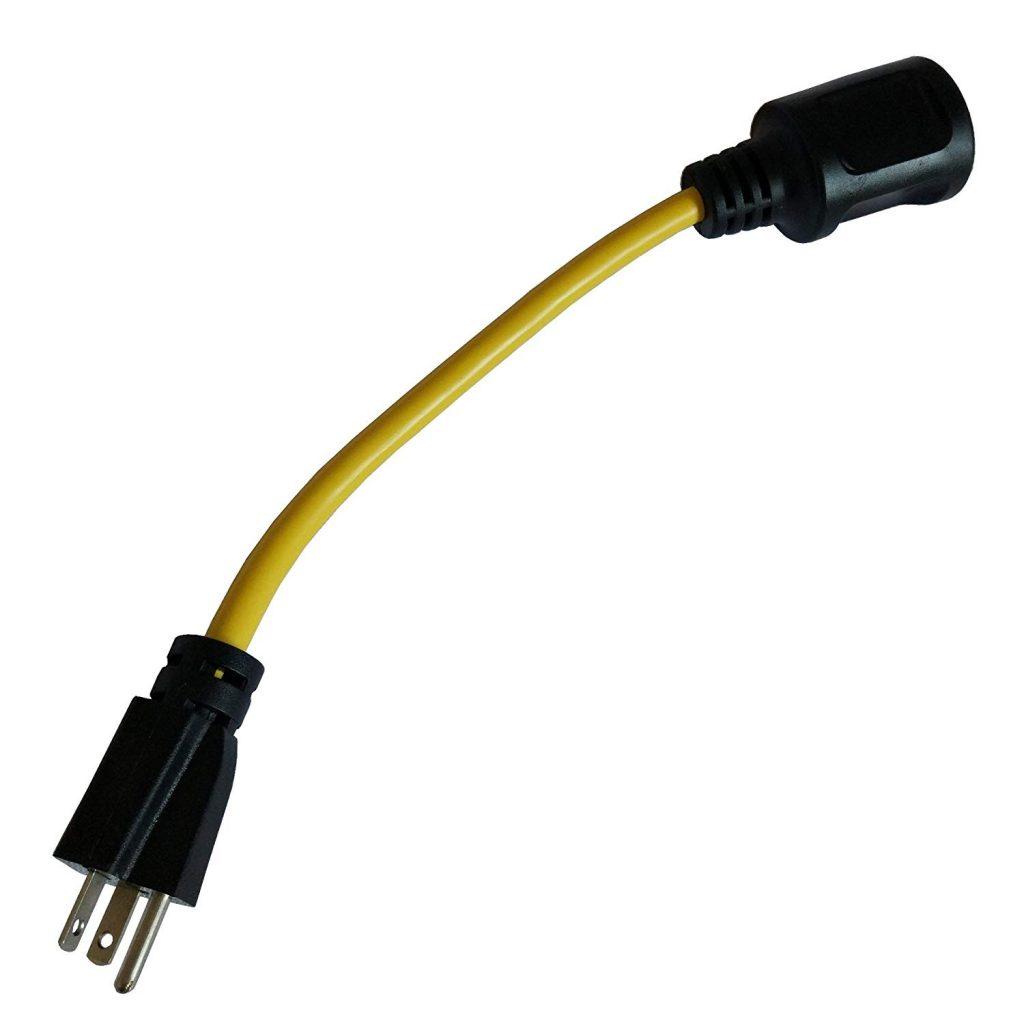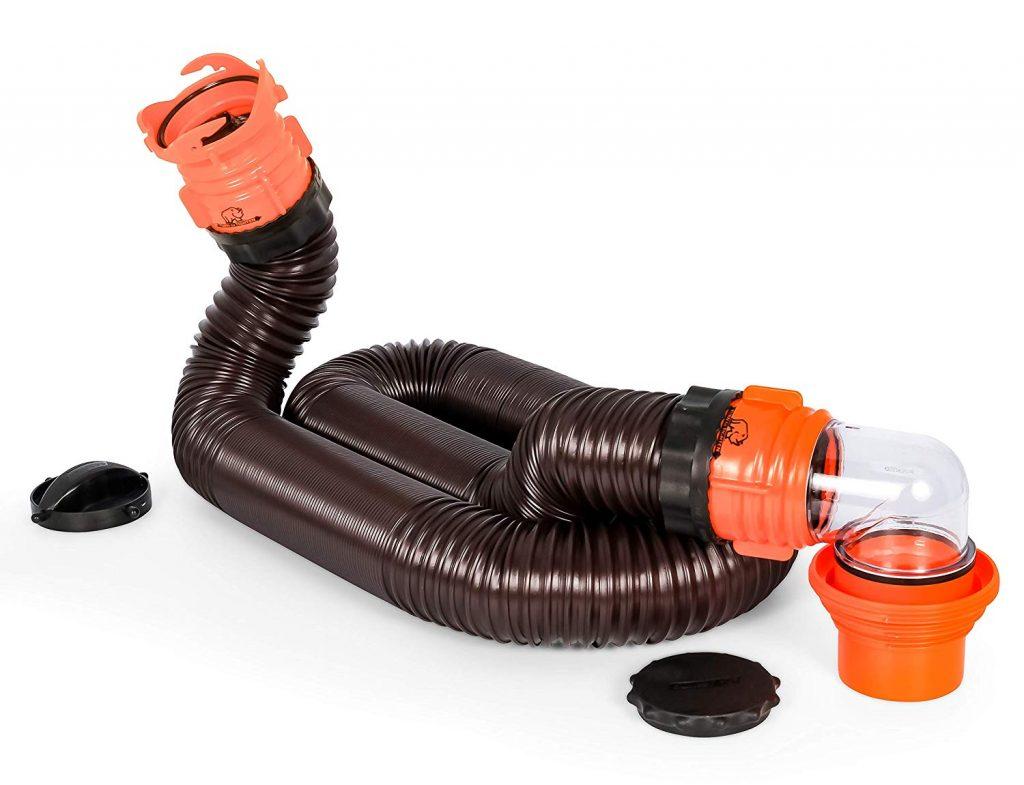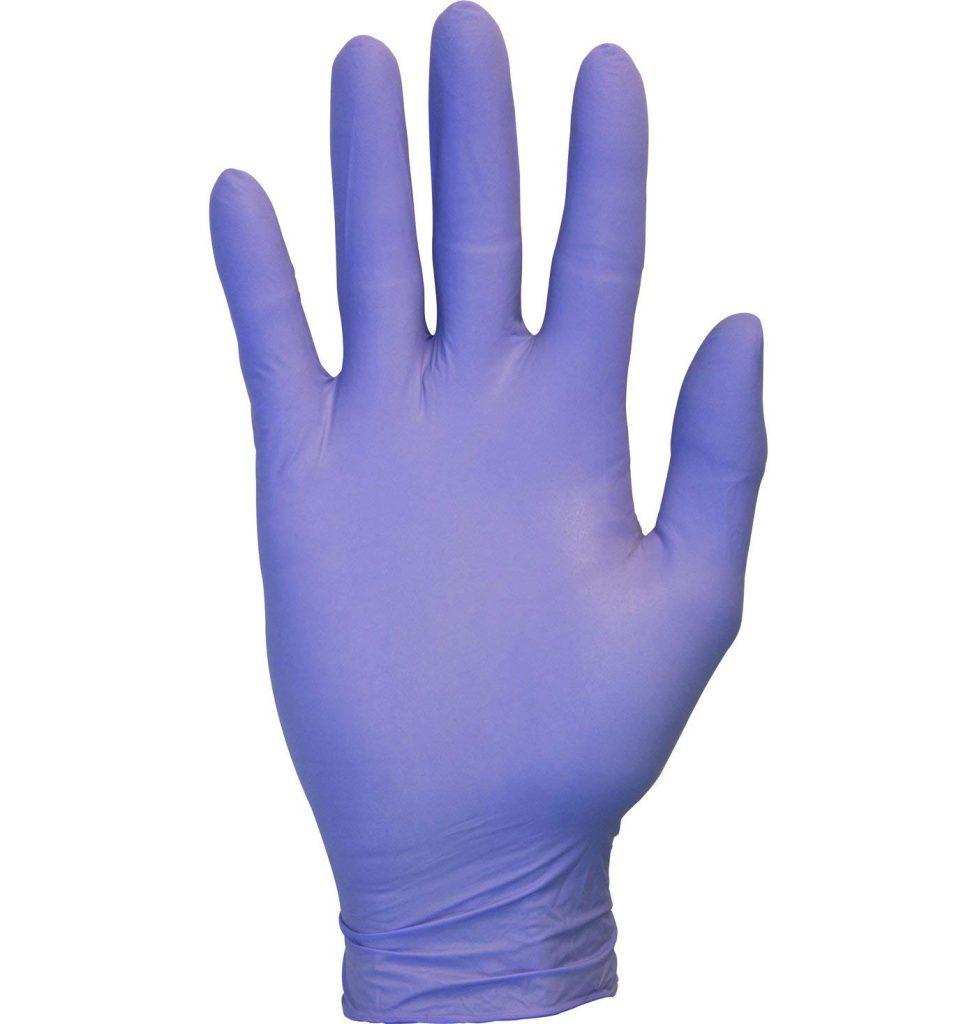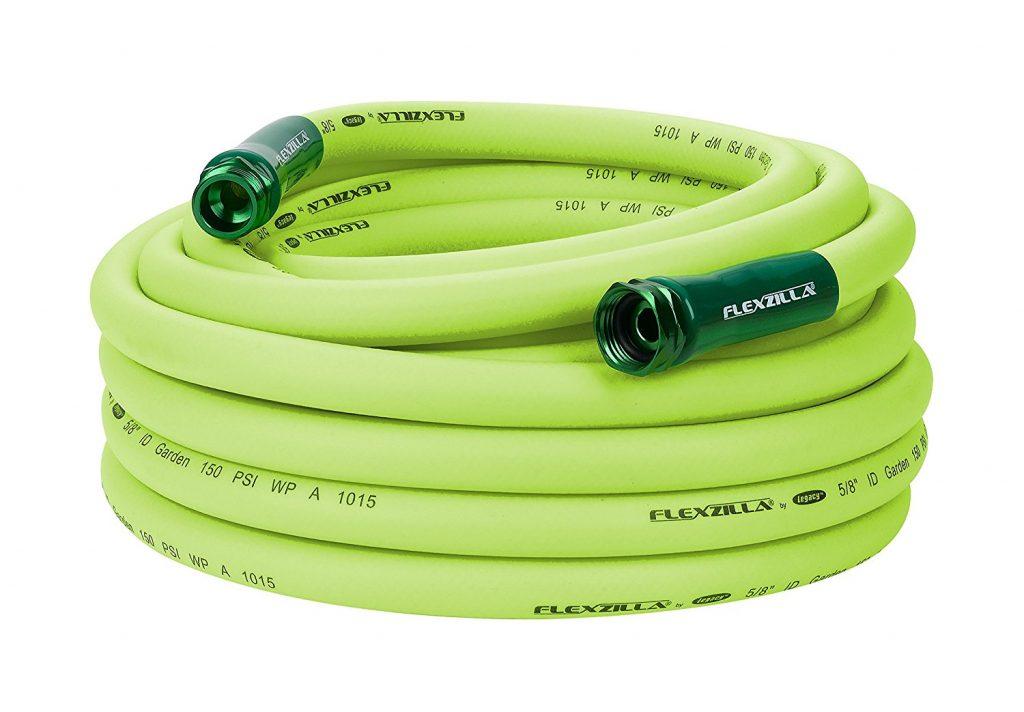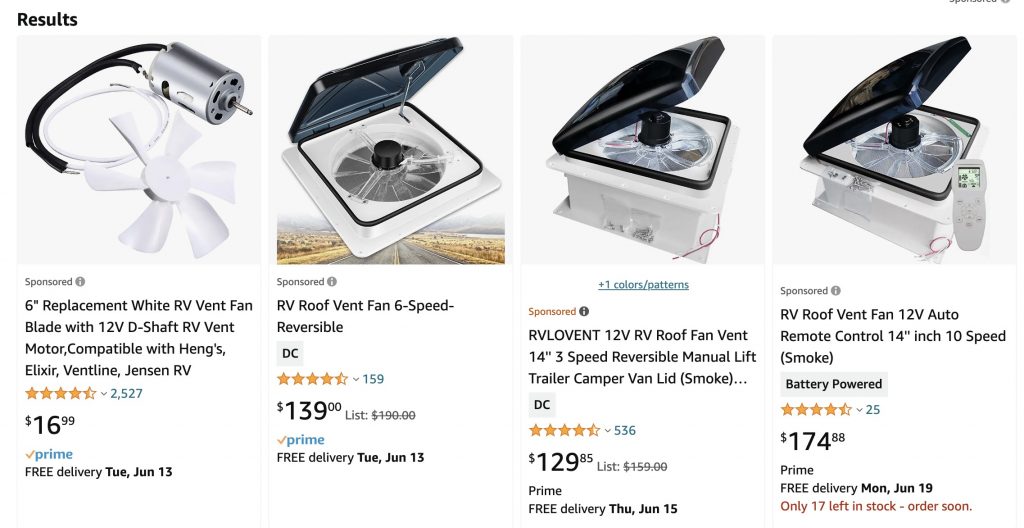When our family left to get on the road full time, my wife and I had never camped together before, and neither of our families owned an RV or travel trailer while we were growing up. We were newbies and knew we were in over our heads.
No amount of Google Searches or Youtube videos could fully prepare us (it’s kinda like ‘preparing’ to become a parent for the first time) so with a willingness to learn and digital marketing business as our sidekick, we headed out on the road.
Thankfully, we’ve survived long enough to share the 15 essential tools from our first 90 days of RV life.
If you’re about to get into RV life full time, make sure you have these things on hand before you leave. Some of these items have been eye-openers for us, and others were “obvious, but we’ll get them when we need them,” but unless you enjoying making an emergency trip to the nearest Walmart in the middle of the night, having these items before you leave will make your future full-time RV life much easier.
In no particular order:
15 Essential tools for your first 90 days of Full-time RV Life.
(side note: if you want to skip each item, we’ve pre-built a wish list on amazon.com here: First 90 Days RV Wishlist. This is an affiliate link. Amazon gives us a commission for referring you, but it doesn’t cost you anything.)
For those of you ready to start RVing and are looking for the “Solar Panel” section, the good news is that solar panels are no an essential for RVing, but if you’re ready to go from visiting campgrounds to RVing off-grid, then here’s what you need to know to get started with installing solar panels and batteries to your RV.
Step Stool:
Within the first 2 weeks of being on the road, the outdoor step fell off of our newly-renovated 1992 Salem Cobra. Repairing the step was actually going to cause strain on the door frame, since the only repair we could come up with was bolting the step back in through the bottom of the door frame.
Instead, we tool the step off and purchased this step stool. Look for a stool that doesn’t have legs or a folding loop that sits higher than the top step. We started with one of those, but it wouldn’t allow us to swing our door open.
Other than an actual doorstep, this is also helpful for cleaning windows, caulking roof lines and reaching things you didn’t imagine you would need to reach.
RV Water Pressure Regulator:
Within the first 3 months of being on the road, our water heater burst. The water heater was probably the original one with the trailer, so at 26 years old, it’s not really a surprise, but the repair shop said it would have lasted longer had we had a pressure regulator on our water line. This wouldn’t have prevented the water tank from bursting (probably from mineral built up), but we could have gotten a little more time out of it.
This regulator reduces the pressure of the water going from wherever you hook up into your RV, motorhome or trailer to be sure that the pressure isn’t unnecessarily high, and it’s important that your regulator is “drinking water safe” since this is the water feeding your kitchen and bathroom faucets.
Even if you’re not actually “drinking” the water (maybe you’re using bottled water or a Brita filter instead) you’ll still be washing your dishes or brushing your teeth with this water.
< Get this water regulator on Amazon
15 amp to 30 amp adapter For RVs:
Depending on your RV’s needs, occasionally you may need to have an adapter for the amperage coming into your unit or for the available electrical hookup at your campsite.
Many campsites offer 30amp or 50amp, so if you’re sticking with just campgrounds, be sure you have the adapter from what your RV needs to adapt to each of these options.
For us, there have been a few opportunities for us to stay in a friend’s driveway for a few nights. Since it would be a very specific feature for a house to have a 30 amp connection as an outdoor outlet, this adapter has been essential for us to connect to any standard outdoor outlet.
(If it’s cold out and you pull into a friend’s driveway without this adapter, you might want to consider these tips to stay warm in an RV)
Keep in mind that you won’t be able to run your A/C, fridge, microwave, and blow dryer all at once since the circuit you’re on is only 20 amp, but it’s enough to keep our electric fridge running, turn on a few lights or have a fan on at night.
The good news is, you’ll still be able to cook in your RV!
RV Sewer hose:
This one is pretty self-explanatory and something I should have bought before we got to our first campground. When I went to the hardware store at our first campground, I picked up a 10ft version, because we needed one and it was all they had in stock. Our experience has been that 15 feet should really be the minimum.
Unless you’re superman when it comes to backing up that trailer so you can get it into the perfect spot every time, or you’re never going to use your tanks (a lofty proposition) there’s no way to guarantee that where you park is within 10 feet of the campsite’s sewer outlet.
Will 15 feet work every time? No guarantees. I’d recommend something longer, but if you’re looking for a minimum, this is it.
(tip: Don’t leave your blackwater tank open all the time. Open it only when you need to drain it. In a nutshell, with the valve open all the time, liquid immediately drains out. “non-liquid’ and paper hits the bottom of the tank and doesn’t always wash away. Then, without any liquid in the tank, the “non-liquid” hardens and reduces the tank capacity. Keeping the tank closed until draining keeps everything in flushable form.)
< Get this sewer hose on Amazon
RV Black Tank Cleaner:
RVing Tip: Don’t leave your blackwater tank open all the time. Open it only when you need to drain it.
In a nutshell, with the valve open all the time, liquid immediately drains out. “Non-liquid” and paper hits the bottom of the tank and doesn’t always wash away. Then, without any liquid in the tank, the “non-liquid” hardens and reduces the tank capacity.
Keeping the tank closed until draining keeps everything in flushable form.
If you’re buying an RV used, you may not be able to get clear information about how well the tank has been kept, and even if your RV is new, rinsing with water is important to empty the tank, but doesn’t completely sanitize it.
As an added measure to break up solids and toilet paper while sanitizing your tank, drop in one of these cleaners between campsites with a few gallons of water so the water and cleaner mix together and slosh around your tank while traveling.
First step at your next site: Drain and rinse the tank.
< Get this Tank Cleaner on Amazon
Rubber Gloves:
While we’re on the subject of draining tanks… These are self-explanatory.
< Get these Rubber Gloves on Amazon
Drinking Water Hose:
Like the sewer hose, there’s no guarantee for how far your water spigot will be from your RV. Since we bought our trailer from someone who was stationary, the 15-foot hose they had suited them fine and was good for our first few sites.
Based on the 18-minute drive each way into town on a stop about 6 weeks into full-time travel, stops at multiple hardware stores all after a day of traveling so we could find a 50-foot, drinking-water-safe hose to hook up our water makes me highly recommend a hose at least 50 feet long.
If you’re feeling economical, you can get the 25-foot hose, which should be sufficient for most sites, but may end up costing you in the end when it’s not quite long enough and you need to replace it anyway.
We now carry both the 15-foot and 50-foot. If the 15ft will reach, then we use that. In cases it won’t, we have the 50-foot available.
< Get this 50 foot hose on Amazon
Cash:
This is one of those ones that seems like a no-brainer – either “obviously, you should have cash on hand” or “Seriously? With today’s technology, we need cash?” – either way, we recommend $100 cash on hand.
We recommend 3 x $20, 2 x $10, 2 x $5 and $10 worth of quarters – It sounds specific but here’s why:
- Some campgrounds require a cash deposit to get a gate card to come and go after hours (for the $5 and $10s on hand). We learned this the hard way one night when I came back late from getting groceries and had to carry 14 bags from the parking lot to our trailer.
- Other campgrounds only accept cash payment (especially if you have a discount membership like Passport America).
- Some laundry and showers require quarters only (or loonies – $1 Canadian coins in Canada), and there’s nothing worse than having a $5 bill and the front desk is out of quarters when you need a shower or put laundry in the wash, then realized you didn’t have quarters for the dryer.
- On top of this, if you are on a toll road and don’t have proper change (some don’t take plastic) they add on an ‘admin’ fee if you mail in the toll later, and one of the most ‘interesting’ reasons we’ve run into is pulling into a gas station or finishing a meal at a restaurant to find out that your bank has put a hold on your cards because you’re traveling.
If you end up spending some of this cash, the next trip out includes a stop at the bank.
Leveling your RV:
 Since each campground (and campsite) is unique, each time you arrive at a new campsite or pull into BLM land for camping you’ll need to level your RV. In some cases, you may have self-leveling mechanisms in your unit, but in many cases, you’ll need to level the unit yourself.
Since each campground (and campsite) is unique, each time you arrive at a new campsite or pull into BLM land for camping you’ll need to level your RV. In some cases, you may have self-leveling mechanisms in your unit, but in many cases, you’ll need to level the unit yourself.
Think you can just eyeball it?
It is incredible how only a few inches off or “pretty close” from eyeballing it outside the trailer can feel like you’re walking around with vertigo inside the trailer.
Just try pouring a cup of water or cracking an egg into a frying pan and you’ll realize how “being not quite level” can really affect your stay, not to mention that your tanks may not fully empty on an angle, or your propane fridge may not cool properly.
For the most part, a magnetic level sitting on the tongue helps us get level front to back, and then sit this on the back bumper as we’re jacking up the stabilizers to get side to side.
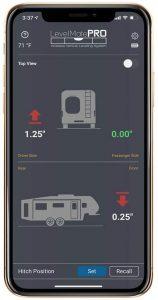 (more recently, we’ve added on a Level Mate Pro, which connects to your phone VIA bluetooth to get you level both front to back and side to side within a 1/4 inch! This is a lifesaver for figuring out how many leveling pads we need to put on either side of the RV to be sure we’re level once the slide is out.)
(more recently, we’ve added on a Level Mate Pro, which connects to your phone VIA bluetooth to get you level both front to back and side to side within a 1/4 inch! This is a lifesaver for figuring out how many leveling pads we need to put on either side of the RV to be sure we’re level once the slide is out.)
Leveling your RV is one of our favorite 21 RV Life Hacks that will make your RVing experience more enjoyable.
Water Filter:
When we arrived at our first campground, the first trip had shaken loose some mineral sediment that was in the pipes and clogged up the kitchen faucet.
This has been an ongoing chore of cleaning out the filter in the faucet since the previous owner didn’t use a filter and each trip shakes some more sediment loose.
This water filter not only cleans bacteria out of the incoming water but also reduces calcification or mineralization, so your lines continue to run at full capacity.
< Get an RV Water filter on Amazon
RV Sewer Hose Supports:
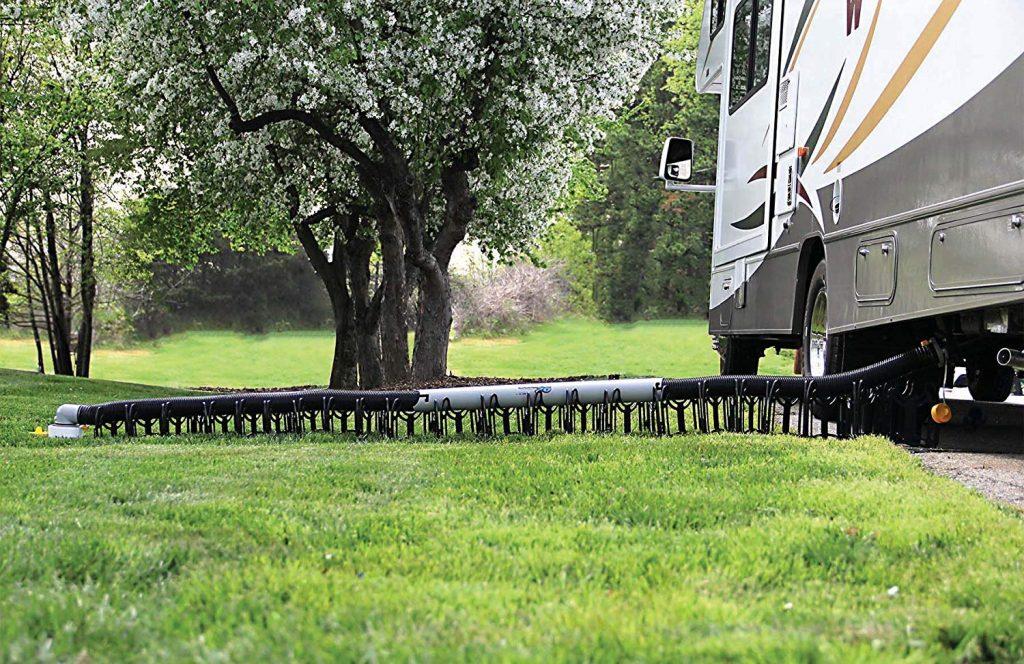 Sometimes called a slunkie, and sometimes called the “Stinky Slinky”… RVers have some odd terms. If you’re new to RV Life, here are 9 basic terms for full-time RV living that might help.
Sometimes called a slunkie, and sometimes called the “Stinky Slinky”… RVers have some odd terms. If you’re new to RV Life, here are 9 basic terms for full-time RV living that might help.
Just like in the picture, your sewer connection will not always perfectly sit over the sewer drain, and since your sewer hose works on gravity, having a support system stops your hose from dipping down between your tank and the drain, avoiding any sewage stuck between the high points at each end.
Visually, this also helps avoid someone (ie. your kids, hypothetically of course) tripping over your hose because it now sits up from lying on the ground.
< Get this sewer support on Amazon
LED Flashlights:
 Compact LED flashlights take up less room than traditional flashlights, use less battery power, so the batteries last longer and the bulbs last for years (compared to traditional flashlights where you may have fresh batteries at the exact moment that the bulb needs to be replaced.
Compact LED flashlights take up less room than traditional flashlights, use less battery power, so the batteries last longer and the bulbs last for years (compared to traditional flashlights where you may have fresh batteries at the exact moment that the bulb needs to be replaced.
We keep flashlights in the car, kids room, our bedroom and in the cutlery drawer. It may seem like overkill, but we’ve experienced the campground electrician working on setting up some new sites a row down, so the power goes out, a thunderstorm suddenly rolls in, a weird sound under the car while we’re driving, or the kids need to use the bathroom in the middle of the night.
At those moments, those flashlights don’t seem like overkill and are much safer in the trailer compared to candles.
< Get these flashlights on Amazon
Public Goods Personal Care Products:
 Hang tight with me. This isn’t as random as it seems. Before we went full-time, we learned about Public Goods and their all-natural products cleaning products at wholesale prices, but what makes them perfect for our RV is 3 reasons:
Hang tight with me. This isn’t as random as it seems. Before we went full-time, we learned about Public Goods and their all-natural products cleaning products at wholesale prices, but what makes them perfect for our RV is 3 reasons:
- The simplicity of their packaging: In our bathroom and kitchen, we don’t have multiple different product packages with color schemes, logos, sizes and shapes that really clutter up the look of our already-tiny bathroom or kitchen spaces. All of the Public Goods packaging helps us keep our spaces looking clean.
- Refill packages: Rather than needing to buy new 12 oz bottles when we run out (or store a spare) their refill packages allow us to keep a single set of bottles and top them up as needed on the road.
- Both my wife and I love the products: They don’t have feminine or masculine scents, so instead of my wife and I each needing a set of our own personal care products, we have a single set that we (and our kids) all share. This helps us keep the space needed for our necessities to a minimum.
Walkie Talkies:
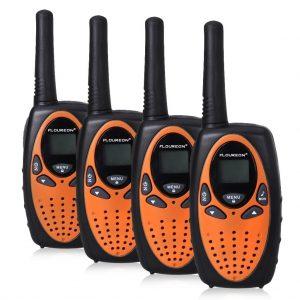 Since we’re camping with kids, we look for campgrounds that have activities for them. We’ve been able to find campgrounds with horseshoes, mini golf, splash pads, candy stores and playgrounds for our kids to enjoy.
Since we’re camping with kids, we look for campgrounds that have activities for them. We’ve been able to find campgrounds with horseshoes, mini golf, splash pads, candy stores and playgrounds for our kids to enjoy.
Walkie Talkies have given us the opportunity to call them back for dinner, let them get ahold of us if they need something (like a major emergency requiring a bandaid and a hug) or just check-in with them to find out where they are and how they’re doing.
They also come with the “fun factor” where our boys will use them as toys, while we can still hear what’s going on between them.
Secondarily, we’ve used these to talk between our driver and someone helping back up the trailer, but for the most part, unless we’re in a remote area, our cell phones work for this purpose.
< Get these Walkie Talkies on Amazon
Dicor RV Caulk:
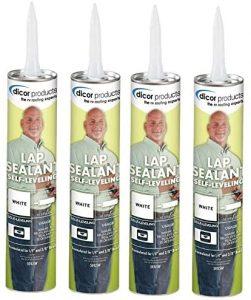 You may think you’ll do a regular maintenance caulk each season or that if something comes up, you can easily get caulk anywhere, but when you wake up in the middle of that rainstorm at 4 am to the dripping of water on your forehead, you may change your mind about how convenient it would be to simply “run out to Walmart and grab some caulk.”
You may think you’ll do a regular maintenance caulk each season or that if something comes up, you can easily get caulk anywhere, but when you wake up in the middle of that rainstorm at 4 am to the dripping of water on your forehead, you may change your mind about how convenient it would be to simply “run out to Walmart and grab some caulk.”
While most caulk can’t be applied in a rain storm, get some dicor BEFORE you get on the road, inspect your roof regularly, and you won’t have to grab emergency tarps in the middle of the night.
BONUS: RV Vent Fan
There are plenty of options for RV Fans, whether you’re looking for an RV ceiling fan, a handheld fan, or one that sits on the floor and moves a lot of air.
We put this as a “bonus” since many newer RVs have vent fans, but many older ones don’t. If you don’t have one, they’re are a great investment which will give you some air movement without taking up any floor or storage space.
We’ve often found that some air movement helps to keep the air in our RV fresh – not necessarily that we need the air conditioner (but here are some tips to keep your RV cool in the summer).
If your RV doesn’t have a ceiling vent fan, this investment is worth every penny – not only for comfort, but for cost savings if you can simply turn on the vent fan to clear the kitchen smells or bring in some fresh air instead of having to pay to run your air conditioning.
New to RVing? This might be helpful:
Since you’re new to RVing, we found that campgrounds were our biggest expense our first year on the road. Here’s how we cut our campground expenses in half by our second year on the road.
While you’re thinking about space and essentials, you may have some family members who don’t quite understand the concept of living in a tiny home and want to “overgift” for kids Christmas and birthday presents. Here’s a post you can pass on. We’ll take the heat for it.
15 Gift Ideas for RVing and Traveling Families
…and you won’t find this on Amazon, but you’ll want to remember to always put gas in the tank. Here’s a story about how we learned the hard way.

